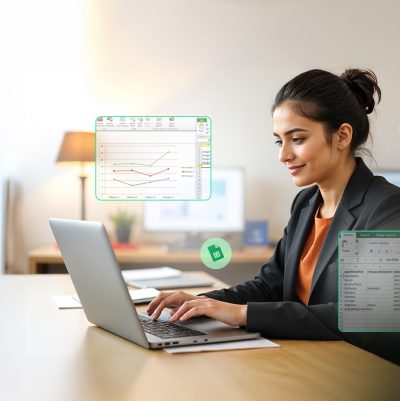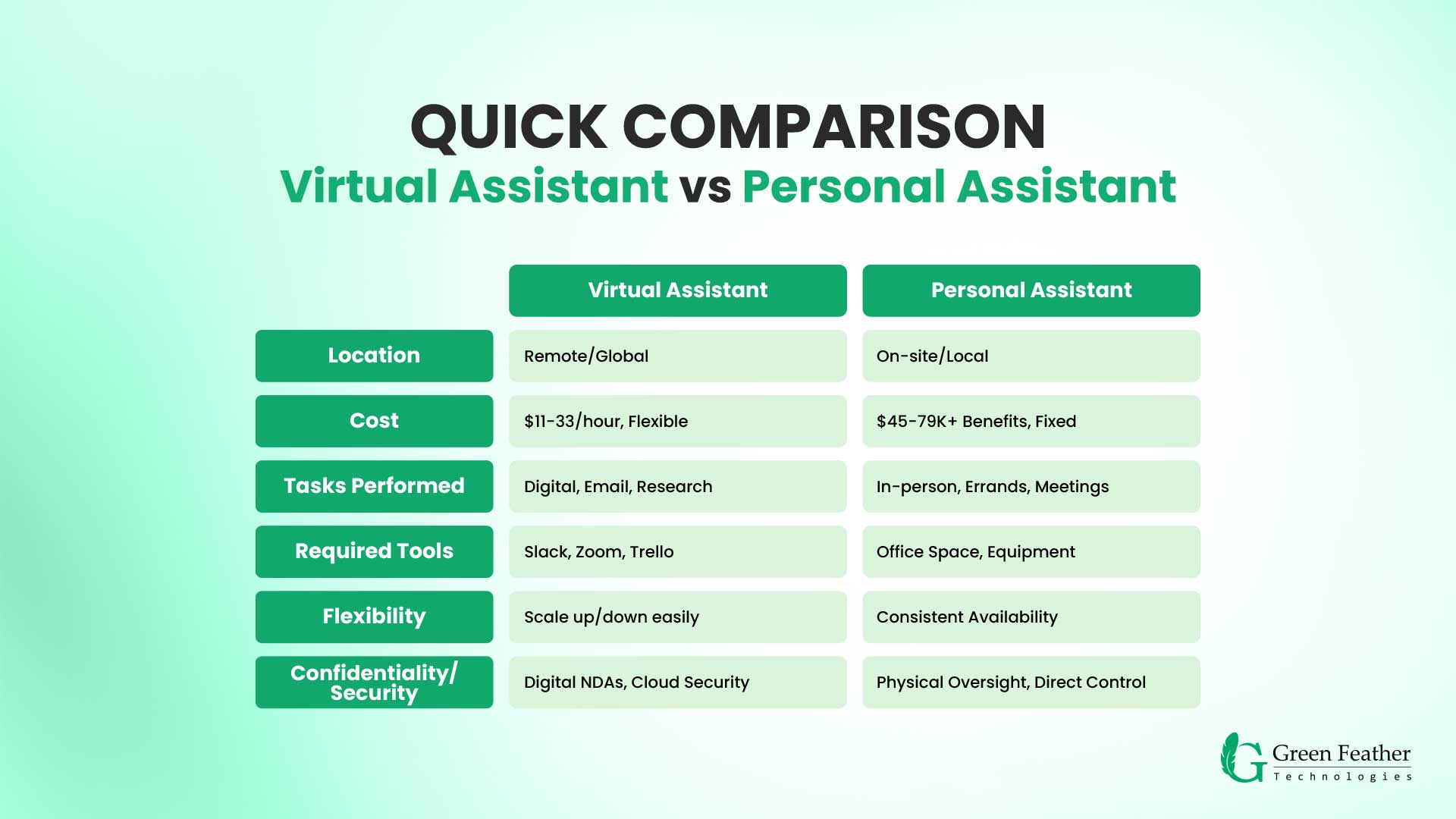Summary
Virtual assistants provide cost-effective, flexible remote support ideal for digital tasks and scalable businesses. In contrast, personal assistants offer dedicated in-person assistance, perfect for executives requiring immediate availability and physical task management.
The shift towards remote work is taking over and changing how businesses operate. According to a research by Roberhalf, fully remote jobs have gone from 10% in 2023, to 13% in 2025. It’s just a testament of the fact that businesses are leaning towards remote jobs as time passes.
With this increasing remote work trends, the debate of virtual assistant vs personal assistant is also making waves. That’s why we have this detailed guide to solve that dilemma and help you choose between PA and VA.
So, if you are confused between the two, this guide is all you need.
1. Cost and Budget Considerations - Virtual Assistant vs Personal Assistant
When you are going through the difficult decision of hiring virtual assistants vs personal assistants you have to understand the financial implications. It’s important because the cost structures differ significantly. So, here’s a breakdown of the cost considerations you need to make –
Hourly Rates and Salaries
The hourly rates and salaries vary a lot between the two assistant choices.
- Virtual Assistants: Virtual assistants typically offer flexible pricing models that can adapt to your business needs. According to Ziprecruiter, most VAs charge between $11-33 per hour depending on their expertise, location, and specialization.
You can also use project based pricing for them if you feel the need for a VA based on projects. This flexibility allows you to scale up during busy periods and reduce costs during slower times. - Personal assistants: On the other hand, personal assistants usually require full-time employment with comprehensive benefits packages. According to Glassdoor, the salary for a personal assistant ranges from $45,000 to $79,000 annually.
In addition to the salary, they also get health insurance, vacation time, retirement contributions, and other employee benefits. This creates a fixed cost structure that remains constant regardless of workload fluctuations.
2. Hidden Costs vs Long-Term Value
Consider the hidden expenses accompanying each option when hiring virtual assistants vs personal assistants.
- Virtual Assistants: Virtual assistants may require subscriptions to collaboration tools like Slack, Zoom, Trello, or project management platforms. However, these costs are typically minimal compared to the expenses associated with a personal assistant.
- Personal Assistants: Personal assistants require office space, equipment, training programs, and ongoing supervision. You must provide a workstation, computer, phone system, and office supplies. Additionally, consider costs related to recruitment, onboarding, and potential turnover. These can increase the upfront and ongoing costs, while providing long-term benefits.
3. Communication and Collaboration
The next point of difference to consider between the two choices is communication and collaboration. It all depends on how you want these to work for your business.
Virtual Assistant
Virtual assistants excel in digital communication environments, leveraging tools like:
- Slack, WhatsApp, Telegram or Viber for instant messaging
- Zoom for video conferences
- ClickUp for project management
They’re used to asynchronous communication, allowing them to work across different time zones and provide round-the-clock support.
Personal Assistant
Personal assistants provide real-time, face-to-face communication that facilitates immediate problem-solving and nuanced understanding of complex instructions. This direct interaction allows instant clarification, non-verbal communication cues, and the ability to handle sensitive matters with greater discretion.
4. Supervision and Training Differences
Another key difference between virtual assistant and personal assistant is how you manage them. Let’s explore the differences:
Managing a Virtual Assistant
Virtual assistant management relies heavily on digital documentation and structured processes. Effective VA management involves the following –
- Creating detailed Standard Operating Procedures (SOPs)
- Utilizing screen recording tools like Loom for training videos
- Implementing project management systems such as Trello, Jira or Notion for task tracking
This approach requires an initial time investment in creating comprehensive documentation, but results in scalable, repeatable processes that multiple VAs can consistently follow.
Managing a Personal Assistant
Personal assistant management involves traditional, hands-on supervision with physical onboarding processes. This includes –
- In-person training sessions
- Direct observation of work quality
- Regular face-to-face performance reviews
This approach requires more intensive initial supervision. But it also allows for immediate feedback, relationship building, and the development of intuitive understanding.
From scheduling to small tasks, our trained virtual PAs help busy professionals stay focused on high-impact work.

5. Security and Confidentiality
The question of security and confidentiality often arises when choosing between virtual assistants and personal assistants. You need to weigh the different protective measures and protocols to decide.
Virtual Assistant
Virtual assistants require robust digital security measures including –
- Comprehensive Non-Disclosure Agreements (NDAs)
- Secure login protocols through password managers like LastPass
- Restricted access to sensitive systems
Cloud-based security measures, two-factor authentication, and regular security audits become essential when working with remote team members who access your business systems from various locations.
Personal Assistant
Personal assistants benefit from in-person oversight and physical control over sensitive documents and information. This proximity allows for –
- Direct supervision of confidential matters
- Secure physical document handling
- Immediate response to security concerns
However, personal assistants still require proper NDAs and may need access to digital systems, necessitating similar cybersecurity measures.
6. Task Suitability: Which Assistant fits which Task?
Understanding which tasks best suit each type of assistant helps optimize efficiency. It also ensures you’re utilizing the right resource for specific responsibilities.
Virtual Assistant’s Tasks
Virtual assistants excel at digital-focused tasks that can be performed remotely. These can be –
- Email management and filtering
- Social media content creation and scheduling
- Online research and data compilation
- Digital marketing campaigns
- Customer service through chat or email
- Bookkeeping and invoice management
- Content writing and blog management
- Online appointment scheduling
Their expertise in digital tools and platforms makes them particularly valuable for businesses with strong online presence requirements.
Personal Assistant’s Tasks
Personal assistants are ideal for tasks requiring physical presence or in-person coordination. These responsibilities are –
- On-site document management and filing
- Coordinating in-person meetings and events
- Running errands and making purchases
- Managing physical mail and packages
- Overseeing office operations and vendor relationships
- Providing in-person customer service
- Handling confidential document preparation
- Managing executive calendars with complex scheduling requirements
Which One Should You Hire - Virtual Assistant vs Personal Assistant?
At the end of the day, there’s no ultimate choice between virtual assistants vs. personal assistants. It all depends on your business and what it needs to thrive. Here’s a quick rundown on each scenario –
When to choose virtual assistants?
Choose a virtual assistant if your business –
- Operates with budget constraints, requiring cost-effective solutions
- Operates primarily in digital environments
- Requires flexible scaling of support services
- Manages distributed teams across multiple locations
- Focuses on online marketing and customer engagement
- Needs specialized skills for specific projects
- Requires real-time assistance but not physical presence at your location
Virtual assistants are particularly valuable in remote-first cultures. They can benefit entrepreneurs, consultants, and e-commerce businesses.
When to choose personal assistants?
Opt for a personal assistant if your role –
- Involves extensive in-person meetings and events
- Requires management of physical documents and office operations
- Demands immediate availability for urgent situations
- Involves high-stakes confidential matters requiring discrete handling
- Includes tasks that can only be performed on-site or require a physical presence
Personal assistants are essential for C-level executives, professionals in traditional industries, and businesses with significant physical operations.
Now, if virtual assistants are the way to go for you, then the next step is to find the perfect one for your needs. That’s where Green Feather Technologies swoops in with a highly skilled and trained virtual assistant. They combine the flexibility of remote work with the dedication of typical personal support.
You may also like: Virtual Assistant vs Employee – Which One Should I Hire?
Conclusion
The choice between virtual assistant vs personal assistant ultimately depends on your specific business needs, budget constraints, and operational preferences.
Virtual assistants offer cost-effective, flexible solutions ideal for digital-first businesses and entrepreneurs requiring scalable support. Personal assistants provide dedicated, in-person assistance perfect for executives and companies.




